Site of the MOVE Bombing (1985)
Introduction
Text-to-speech Audio
Images
Fires triggered by the attack on Osage Avenue
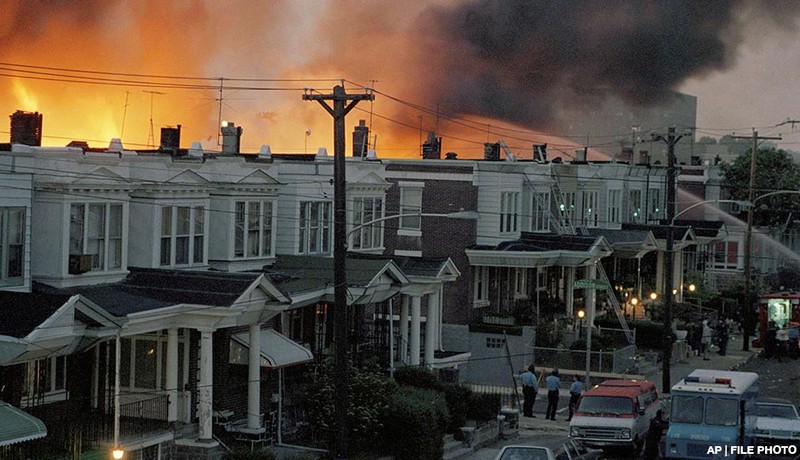
The Aftermath of the Fires
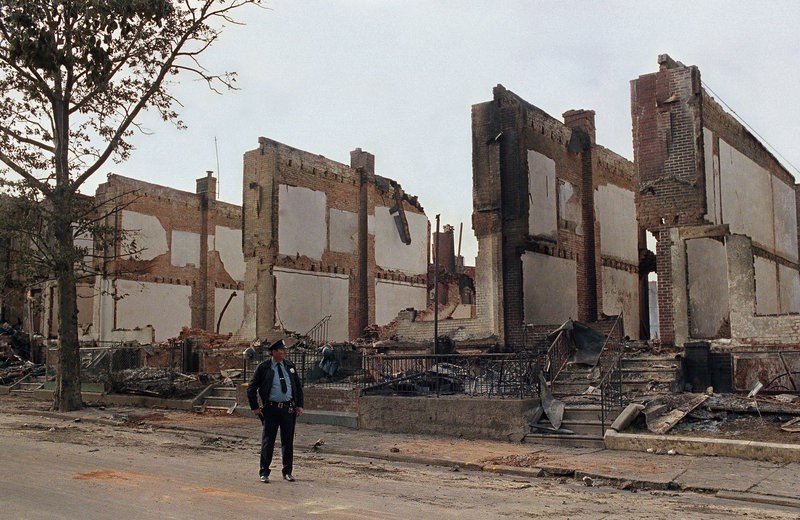
Image of John Africa
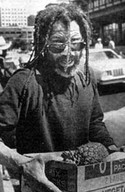
Mayor Wilson Goode Stands on the Roof of One of the Rebuilt Homes
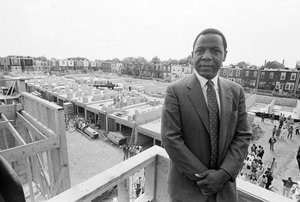
An Aerial View Showing the Extent of the Fire Damage
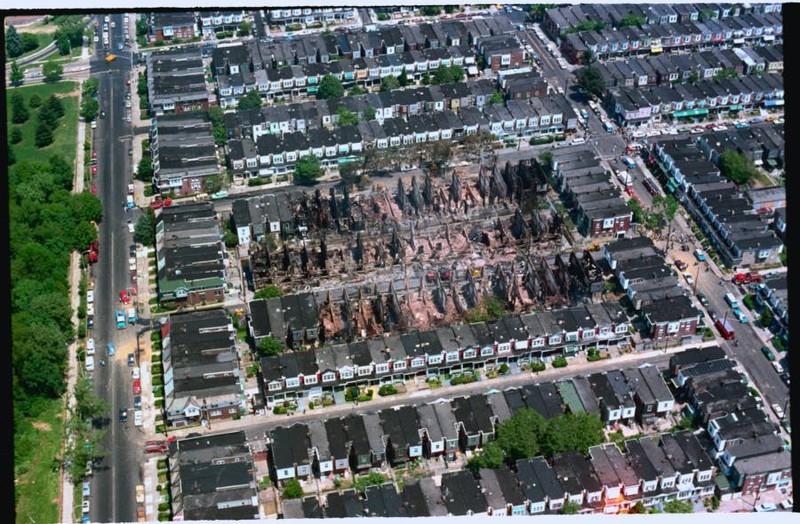
Aerial Image Depicting the Smoldering Remains of the Fire
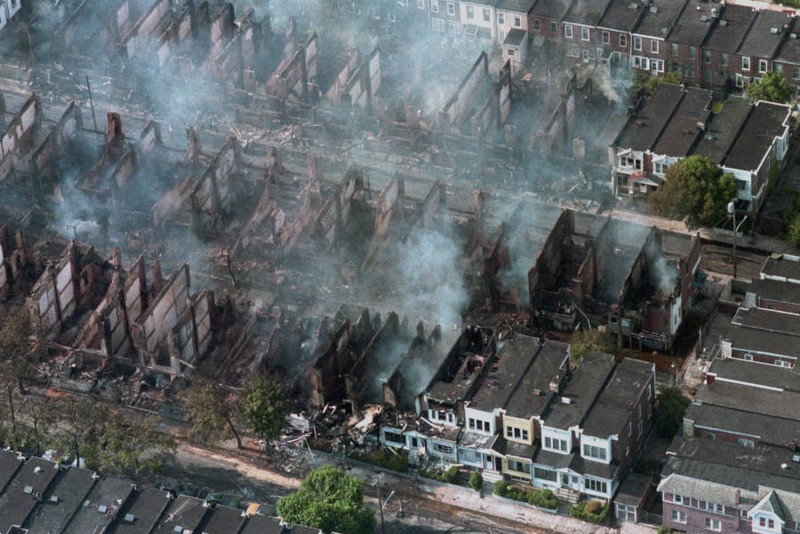
Backstory and Context
Text-to-speech Audio
The organization eventually known as MOVE began in Philadelphia in the 1970s as the American Christian Movement for Life or the Christian Life Movement. The group, which defies easy categorization, was founded by Vincent Leaphart, who took the name John Africa. Africa’s philosophy for the group included Black liberation, communal living, animal rights, and vegetarianism. The group was founded in 1972 and was centered primarily in West Philadelphia.
The first serious confrontation between MOVE and Philadelphia police came on August 8, 1978, when officers attempted to evict the group from its compound in Powelton Village. The move came after numerous complaints from neighbors about unsanitary living conditions in the building, the number of animals on the property, and the group’s use of a bullhorn to broadcast John Africa’s teachings, as well as numerous other issues.
Police attempted to remove residents from the house with a battering ram and water cannons and members of MOVE opened fire. In the melee, a police officer named James Ramp was fatally shot and several others were injured. Though the exact events leading to Ramp’s death are disputed, two years later, nine members of MOVE were convicted of murder and sentenced to between 30 and 100 years in prison.
Following the shootout at Powelton Village, MOVE set up a new compound at 6221 Osage Avenue in a middle-class, African American neighborhood. The group gradually turned their row house into a fortress of sorts, with boarded up windows and a bunker on the roof. Their unorthodox behavior continued, alienating neighbors, who eventually contacted the police. The police issued warnings to the group, which remained belligerent and continued broadcasting its tirades over loudspeaker. MOVE members refused to leave the building or to allow the children inside to leave.
On May 13, 1985, hundreds of police officers, a bomb squad and several fire trucks arrived at Osage Avenue. They turned fire hoses on the residence and when MOVE members refused to leave the building, police blew holes in the walls to fumigate the building with tear gas. When the tear gas failed to force the residents out, a shootout ensued, with police firing thousands of rounds into the building. Police then decided to bomb the rooftop bunker by dropping C4 explosives from a Pennsylvania State Police helicopter. The powerful explosives triggered a fire and, concerned that firefighters would be injured in the ongoing shootout between police and MOVE members, city officials made the controversial decision to let the fire burn. In a neighborhood of rowhomes and narrow streets, it spread over several blocks, leaving 250 people homeless as the city watched the event play out on live television. Six adults and five children were killed in the attack, leaving only two survivors from the Osage Avenue residence: Ramona Africa and thirteen-year-old Birdie Africa, who later began using his birth name of Michael Ward.
In the aftermath of the bombing, Mayor Wilson Goode, Philadelphia's first African American mayor and the person many Philadelphia residents blame for the attack, convened a committee to investigate the bombing. The result was a report that denounced virtually every level of city government involved in the attack, concluding that "dropping a bomb on an occupied rowhouse was unconscionable." Mayor Goode maintains that he ordered the fire be put out, but the city's fire commissioner testified that he never received the order. Ramona Africa was convicted on riot charges and served seven years in prison, but in 1996, she and relatives of some of the MOVE victims killed in the fire won a $1.5 million settlement from the city.
Osage Avenue and some of the surrounding streets have never fully recovered from that day in 1985. The city eventually hired developers to rebuild the neighborhood but the homes were shoddily constructed, and in the 2000s, the city offered to buy back the homes for $150,000 each. Many residents took the buy out and left the neighborhood, an exodus which further damaged the beleaguered area. As of this writing, many of the buildings remain vacant and boarded up, including the rebuilt home at 6221 Osage.
Sources
Demby, Gene. What It's Like Living on the Block that Philadelphia Bombed 30 Years Ago. NPR. May 13, 2015. Accessed January 28, 2019. https://www.npr.org/sections/codeswitch/2015/05/13/406175991/what-its-like-to-live-on-the-block-that-philadelphia-bombed-30-years-ago.
Tomek, Beverly C.. MOVE. The Encyclopedia of Greater Philadelphia. . Accessed January 28, 2019. https://philadelphiaencyclopedia.org/archive/move/.
Stevens, William K.. Police Drop Bombs on Radicals' Home in Philadelphia. New York Times. May 14, 1985. Accessed January 28, 2019. https://www.nytimes.com/1985/05/14/us/police-drop-bomb-on-radicals-home-in-philadelphia.html.
https://www.vox.com/the-highlight/2019/8/8/20747198/philadelphia-bombing-1985-move
https://usatoday30.usatoday.com/news/nation/2005-05-11-philadelphia-bombing_x.htm
